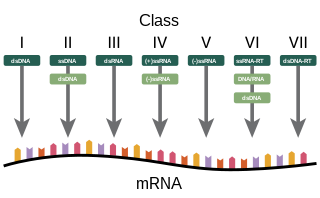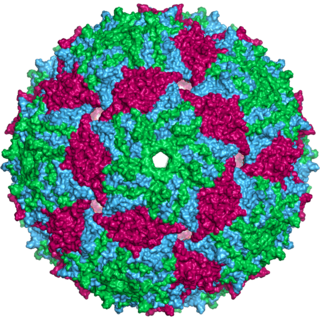
Flaviviridae is a family of enveloped positive-strand RNA viruses which mainly infect mammals and birds. They are primarily spread through arthropod vectors. The family gets its name from the yellow fever virus; flavus is Latin for "yellow", and yellow fever in turn was named because of its propensity to cause jaundice in victims. There are 89 species in the family divided among four genera. Diseases associated with the group include: hepatitis (hepaciviruses), hemorrhagic syndromes, fatal mucosal disease (pestiviruses), hemorrhagic fever, encephalitis, and the birth defect microcephaly (flaviviruses).

Barnaviridae is a family of non-enveloped, positive-strand RNA viruses. Cultivated mushrooms serve as natural hosts. The family has one genus, Barnavirus, which contains one species: Mushroom bacilliform virus. Diseases associated with this family includes La France disease.

Dicistroviridae is a family of viruses in the order Picornavirales. Invertebrates, including aphids, leafhoppers, flies, bees, ants, and silkworms, serve as natural hosts. There are 15 species in this family, assigned to three genera. Diseases associated with this family include: DCV: increased reproductive potential. extremely pathogenic when injected with high associated mortality. CrPV: paralysis and death.

Nodaviridae is a family of nonenveloped positive-strand RNA viruses. Vertebrates and invertebrates serve as natural hosts. Diseases associated with this family include: viral encephalopathy and retinopathy in fish. There are nine species in the family, assigned to two genera.

Tombusviridae is a family of single-stranded positive sense RNA plant viruses. There are three subfamilies, 17 genera, and 95 species in this family. The name is derived from Tomato bushy stunt virus (TBSV).

Baltimore classification is a system used to classify viruses based on their manner of messenger RNA (mRNA) synthesis. By organizing viruses based on their manner of mRNA production, it is possible to study viruses that behave similarly as a distinct group. Seven Baltimore groups are described that take into consideration whether the viral genome is made of deoxyribonucleic acid (DNA) or ribonucleic acid (RNA), whether the genome is single- or double-stranded, and whether the sense of a single-stranded RNA genome is positive or negative.

Cardiovirus are a group of viruses within order Picornavirales, family Picornaviridae. Vertebrates serve as natural hosts for these viruses.

Totivirus is a genus of double-stranded RNA viruses in the family Totiviridae. Fungi serve as natural hosts. The name of the group derives from Latin toti which means undivided or whole. There are seven species in this genus.
Dianthovirus is a genus of viruses, in the family Tombusviridae. Dianthoviruses are plant viruses. There are three species in this genus. The virus probably has a worldwide distribution, and can be transmitted via nematodes, by mechanical inoculation, by grafting of plants and by contact between infected hosts with previously uninfected host.
Teschovirus is a genus of viruses in the order Picornavirales, in the family Picornaviridae. Pigs serve as natural hosts. There are two species in this genus, including Teschovirus A, which is responsible for the porcine enteroviral encephalomyelitis disease caused in pigs. The genus name comes from this species and the disease it causes: Teschen disease, which itself was named for the town Teschen in Poland/Czechoslovakia where the disease was first recognised in 1929.

Sobemovirus is a genus of viruses. Plants serve as natural hosts. There are 20 species in this genus. Diseases associated with this genus include: mosaics and mottles.

Iflaviridae is a family of positive sense RNA viruses insect-infecting viruses. Some of the insects commonly infected by iflaviruses include aphids, leafhoppers, flies, bees, ants, silkworms and wasps. The name "Ifla" is derived from the name "Infectious flacherie virus", a member species. There is one genus (Iflavirus) and 16 species in this family.

Alphaflexiviridae is a family of viruses in the order Tymovirales. Plants and fungi serve as natural hosts. There are 65 species in this family, assigned to six genera. Diseases associated with this family include: mosaic and ringspot symptoms.
Cricket paralysis virus (CrPV) was initially discovered in Australian field crickets by Carl Reinganum and his colleagues at the Victorian Plant Research Institute. The paralytic disease spread rapidly through a breeding colony as well as through a laboratory population causing about 95% mortality. This was the first recorded isolate of the virus and is generally referred to as CrPVvic to distinguish it from subsequent isolates.

Virgaviridae is a family of positive-strand RNA viruses. Plants serve as natural hosts. The name of the family is derived from the Latin word virga (rod), as all viruses in this family are rod-shaped. There are currently 59 species in this family, divided among seven genera.

Qubevirus is a genus of positive-strand RNA viruses, in the family Fiersviridae. Enterobacteria serve as natural hosts. There are two species in this genus. In 2020, the genus was renamed from Allolevivirus to its current name.

Emesvirus is a genus of positive-strand RNA viruses, in the family Fiersviridae. Enterobacteria serve as natural hosts. There are three species in this genus. In 2020, the genus was renamed from Levivirus to its current name.

Carmotetraviridae is a family of positive-strand RNA viruses. There is only one genus in this family, Alphacarmotetravirus, which has one species: Providence virus. Lepidopteran insects serve as natural hosts.
Aparavirus is a genus of viruses in the order Picornavirales, in the family Dicistroviridae. Invertebrates, honeybee, and bumblebees serve as natural hosts. There are six species in this genus. Diseases associated with this genus include: ABPV: paralysis. This virus plays a role in sudden collapse of honey bee colonies infested with the parasitic mite varroa destructor.

Positive-strand RNA viruses are a group of related viruses that have positive-sense, single-stranded genomes made of ribonucleic acid. The positive-sense genome can act as messenger RNA (mRNA) and can be directly translated into viral proteins by the host cell's ribosomes. Positive-strand RNA viruses encode an RNA-dependent RNA polymerase (RdRp) which is used during replication of the genome to synthesize a negative-sense antigenome that is then used as a template to create a new positive-sense viral genome.
















